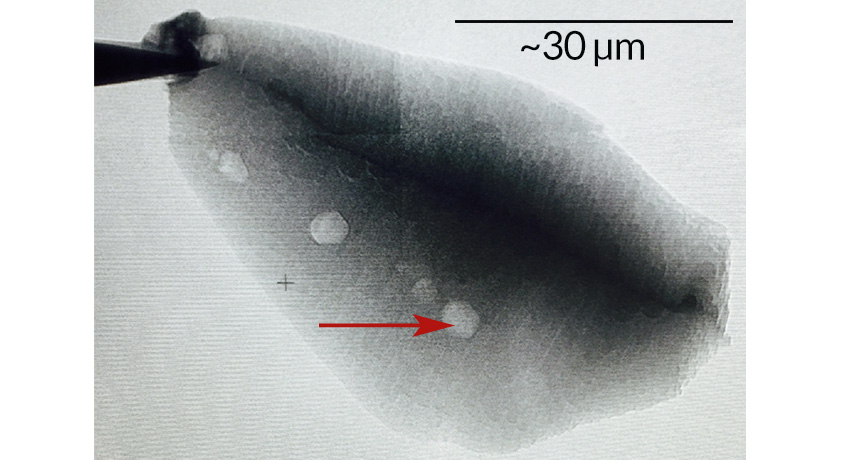News Brief: Rare gem may hold earliest sign of life
A zircon more than 4 billion years old holds what may be remnants of life from back then

This 4.1-billion-year-old zircon crystal contains a small carbon impurity (see red arrow) that is associated with living organisms. (He other light dots are not carbon.)
E.A. Bell et al/PNAS 2015
Researchers have just reported the discovery of what could be the earliest evidence of life on Earth. If confirmed, life emerged at least 4.1 billion years ago. That would make it roughly 300 million years earlier than previous estimates.
The oldest fossils known to show life date back to around 3.5 billion years ago. But what came before the life that made those fossils? It might have been some simple organism with little structure — perhaps no more than a squishy cell of goo. And isolated cells do not easily stand up to being encased in rock.
But fossils come in all types. Some merely record a footprint, shape of a feathers or other passing signs of an organism’s presence. And that’s what scientists think they may have here: a tidbit of carbon. But not just any carbon. It’s carbon-12, a light-weight form of the element. Scientists refer to this as biogenic carbon, as it was apparently left behind by something that was once alive.Carbon comes in several different forms, or isotopes. The largest abundant form is carbon-14; the smallest is carbon-12. Living things tend to preferentially take up and store the smaller form in their cells. So any ancient substance enriched with this carbon-12 would appear to be a sign of a living organism.
Very ancient zircons with carbon inclusions are quite rare. The researchers looked through 10,000 crystals before they found even one. This rarity means the new observation could be difficult to confirm, note Elizabeth Bell at the University of California, Los Angeles, and her colleagues. They reported their new finding October 19 in the Proceedings of the National Academy of Sciences.
Power Words
(for more about Power Words, click here)
biogenic An adjective for something created — or left behind — by a living organism.
carbon The chemical element having the atomic number 6. It is the physical basis of all life on Earth. Carbon exists freely as graphite and diamond. It is an important part of coal, limestone and petroleum, and is capable of self-bonding, chemically, to form an enormous number of chemically, biologically and commercially important molecules.
crystal A solid consisting of a symmetrical, ordered, three-dimensional arrangement of atoms or molecules. It’s the organized structure taken by most minerals. Apatite, for example, forms six-sided crystals. The mineral crystals that make up rock are usually too small to be seen with the unaided eye.
fossil Any preserved remains or traces of ancient life. There are many different types of fossils: The bones and other body parts of dinosaurs are called “body fossils.” Things like footprints are called “trace fossils.” Even specimens of dinosaur poop are fossils. The process of forming fossils is called fossilization.
inclusion (in geology) Something trapped inside a mineral.
isotopes Different forms of an element that vary somewhat in weight (and potentially in lifetime). All have the same number of protons but different numbers neutrons in their nucleus. As a result, they also differ in mass.
Proceedings of the National Academy of Sciences A prestigious journal publishing original scientific research, begun in 1914. The journal’s content spans the biological, physical, and social sciences. Each of he more than 3,000 papers published each year, now, is not only peer reviewed, but also approved by a member of the U.S. National Academy of Sciences.
zircon A gemstone that contains traces of the radioactive element uranium. It develops as a crystal that forms as magma (from deep inside Earth) begins to cool. Some of the oldest minerals surviving on the planet are crystals of zircon that are at least 4.2 billion years old. For perspective, Earth is only 4.56 billion years old.







